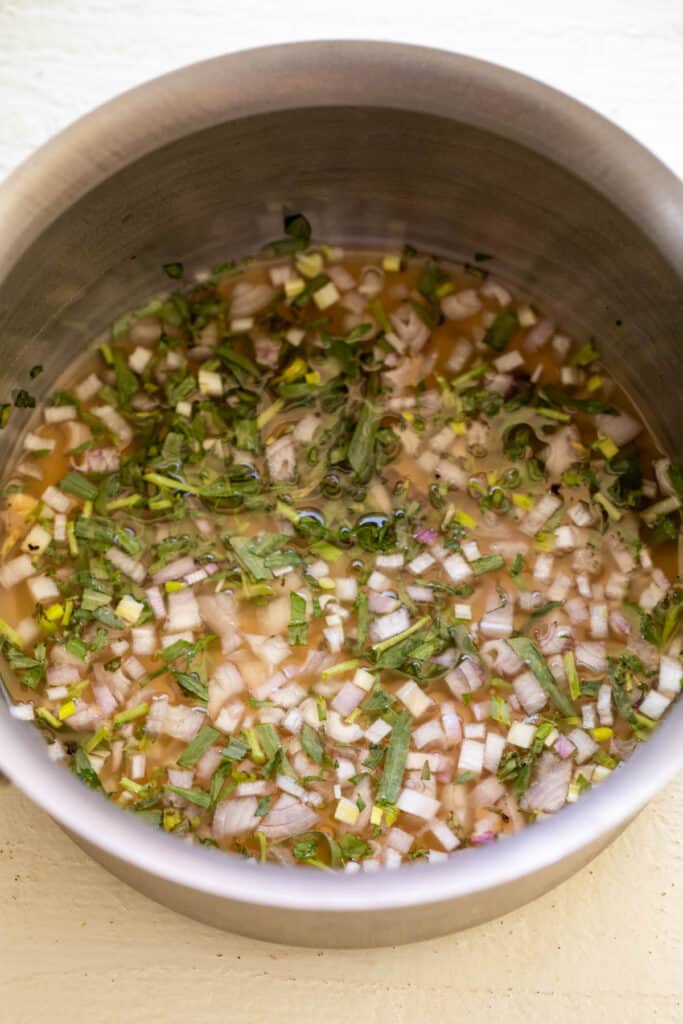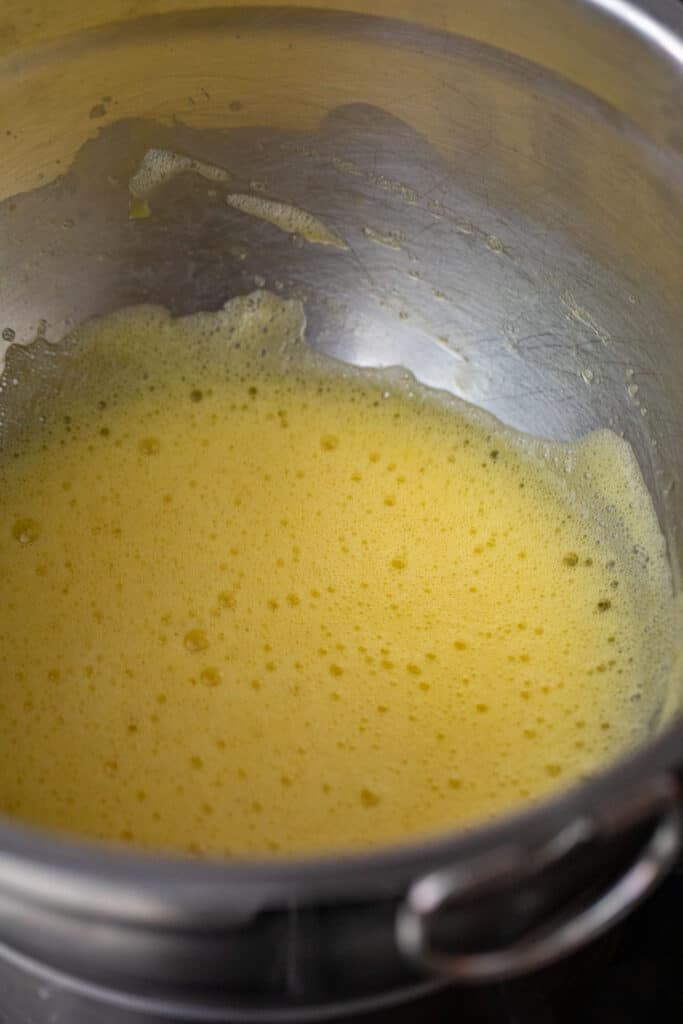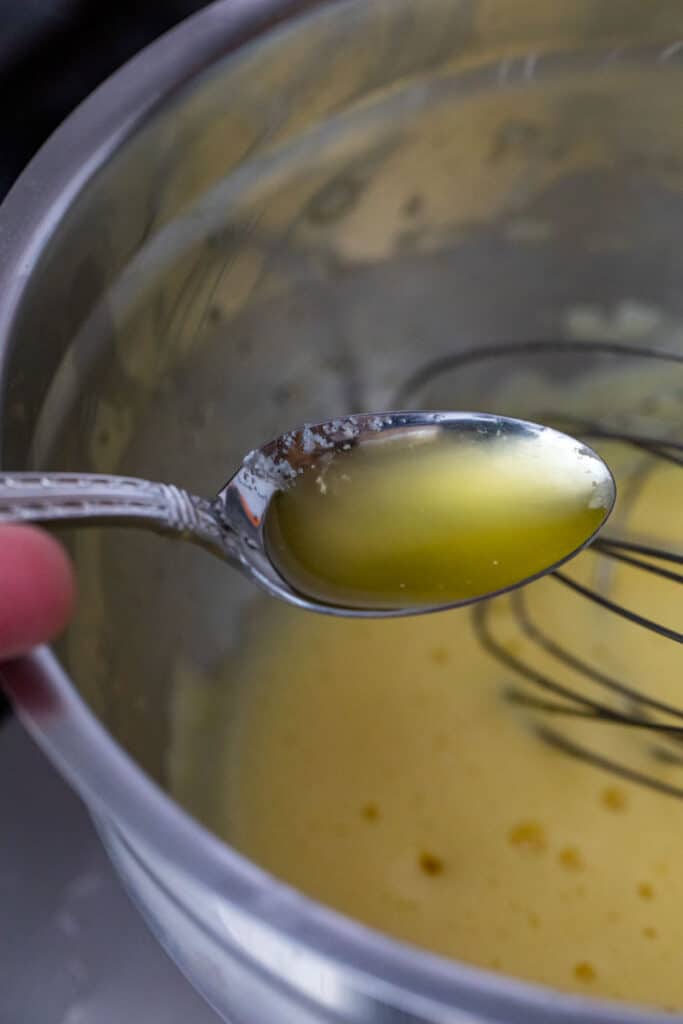Someone can disagree with me if they so choose, but I’m fairly certain that French sauces are the most intimidating thing in the cooking universe. They sound complicated. They look difficult. They taste delicious and therefore must be difficult. This Asparagus with Bearnaise Sauce is a classic example. Simple ingredients, but incredible flavors.
Unless you go to culinary school it’s damn hard to get someone to actually explain how to make a sauce like this correctly.
Since I’ve made Bearnaise like three times (Bearnaising .1000), I will take a stab at explaining how I made it. I was really happy how it turned out and found myself tasting it and re-tasting it not to change the flavors but just to eat as much of it as possible.
Then I drowned some roasted asparagus with the sauce and ate all of it , and let me tell you, this Asparagus with Bearnaise is good stuff!
Roasting the Asparagus
Before we talk about the sauce, let’s talk about the vegetables. For this Asparagus Bearnaise recipe, I just roasted it very simply with a few spices and seasoning. If you don’t cook with asparagus a lot, the trick to cleaning it is to hold the larger end in your hand and press on it with your thumb. The asparagus will naturally snap where hard part meets the soft part.
If you are in a hurry, you could probably just chop off the bottom 2 inches of all of the asparagus and get close. I like the snap method though.
Once you have your asparagus cleaned and snapped, just toss them with some olive oil, salt, pepper, and red pepper flakes. Then toss them all on a baking sheet.
Bake these guys at 400 degrees F for about 12 minutes until they are bright green, slightly soft, but still have some crunch to them. They shouldn’t be completely soggy.

If you’re good, it should almost take the same amount of time to roast the asparagus as make the sauce, but if it’s your first time, the sauce will take you more time. At least, it took me more time…
Keep the asparagus warm in the oven (but turn off the heat) until the sauce is done.
Making the Bearnaise Sauce
If you’ve ever made a hollandaise sauce for eggs benedict, then this will look very familiar. It’s essentially the same technique but has some extra flavors in it, most importantly tarragon.
Start the recipe by adding the vinegar, shallot, crushed peppercorn, and 2 tablespoons of the tarragon to a small saucepan.

Traditionally, you should use half vinegar and half white wine for this recipe but I used all vinegar because it’s what I had. It still tasted delicious. Also, I’m not sure that apple cider vinegar is the traditional choice, but whatever.
French chefs are hating me right now and I haven’t even started the sauce.
Put this saucepan over medium heat and let it cook down until it reduces by half. All of the flavors will be concentrated in a very tiny amount of liquid.Lots of flavor here.

In a medium mixing bowl, whisk together the lemon juice, water, and salt and then strain this vinegar mixture into that liquid. Use a spatula to really press the liquid out of the shallots. You don’t want to actually add the shallots to the sauce though. That would be way too much onion flavor.
From here on out, it is basically like a hollandaise sauce! Melt the butter in a microwave (no need to clarify it) and whisk the egg yolks into the vinegar/water mixture.
Then place the yolks over a double boiler (I just use a small pot with simmering water) and whisk like crazy. As the yolks heat and combine with the water, they will start to foam and basically double in size. When this happens, it’s time to start adding the melted butter. If you happen to have an instant read thermometer, don’t let the egg mixture get above 150˚F or the eggs will start to cook. I usually stop mine around 140˚F just to be safe.

Note: Don’t do other stuff during this process. It’s very easy to over-cook the eggs. If they harden because they get too hot, you basically have to start over.
When you start adding the butter, add it just a few drops at a time to start.

As you whisk in the drops of butter, the sauce should start to turn smooth and silky. After a few rounds of drops of butter, you can start to whisk the butter in using a thin stream. Don’t just dump it in, but pour it in slowly as you whisk furiously. If you’re fast, you can do this while the yolks are over the double boiler, but frankly, I like to take mine off so I can just focus on the whisking. It’s important to return it briefly to the heat source as you whisk though.
After all the butter is incorporated, whisk in fresh tarragon if you want. Even if you don’t use the fresh tarragon, it’ll have lots of tarragon flavor.
Your sauce is done!

You should use it immediately for asparagus bearnaise or cover it with some plastic wrap on the surface of the sauce. It’ll keep okay for an hour or two, but won’t keep much longer than that. I’ve heard that it’s possible to store and reheat the sauce, but I’ve never tried it and I have my doubts that the sauce would be as good on day two.
That said, you can freeze the sauce if you let it cool and vacuum seal it and then reheat it slowly while whisking.
What Can Go Wrong?
Three things I think.
1) You over cook the eggs. You’re screwed. Start over.
2) The sauce is too thick. This can happen if you don’t have enough water in the sauce. As you whisk the butter in, it will turn very thick (think mayonnaise). If this happens, whisk in a teaspoon of cold water and it should normalize.
3) The sauce breaks. If the butter separates out and it looks gross, don’t fret. It will look like a disaster but is actually salvageable. Just whisk together a fresh yolk and a tablespoon of water in a separate bowl. Then slowly whisk the broken sauce into the fresh yolk over the heat source. It should blend perfectly. (This happens to me like 20% of the time when I make hollandaise and this is how I fix it.)
For how few times I’ve made Bearnaise, I really thought it turned out great. If I’m being very critical, it was maybe a tiny bit on the thin side, but held well and had great flavor. It was awesome with the asparagus.
One extra note: This bearnaise recipe makes more than you’ll need for the asparagus alone. Maybe make a steak for the extra? It’s kind of a hard recipe to half honestly, so I would just make a few extra things you can slather in the sauce.

Asparagus with Bearnaise

Ingredients
- 2 large bunches asparagus
- 2 tablespoons olive oil
- ½ teaspoon kosher salt
- ½ teaspoon black pepper
- ¼ teaspoon red pepper flakes
Classic Bearnaise Sauce:
- ¼ cup apple cider vinegar
- ¼ cup fresh tarragon, minced and divided in half
- 6 black peppercorns, crushed
- 1 tablespoon minced shallot
- 4 teaspoons water
- 2 teaspoons lemon juice
- ½ teaspoon salt
- 3 large egg yolks
- 1 ¼ cups unsalted butter, melted
Instructions
For the Asparagus:
- Snap off hard ends of asparagus and toss with olive oil, salt, pepper, and red pepper flakes.
- Lay out asparagus on a baking sheet and bake at 400 degrees Fahrenheit for 10-12 minutes until they are bright green, slightly crunchy still, but cooked through. Keep warm until serving.
For the Bearnaise sauce:
- Combine vinegar, 2 tablespoons fresh minced tarragon, shallot, and crushed peppercorns in a small saucepan. heat over medium heat until the mixture reduces by half.
- In a medium mixing bowl, whisk together water, lemon juice, and salt. Strain in the vinegar mixture and use a spatula to press the liquid through the mesh strainer.
- Whisk yolks into the mixture. Place yolk mixture over a double boiler (I just use a small pan with simmering water). Whisk the yolks constantly as they heat until the yolks are doubled in size and foaming. Be careful not to cook the eggs!
- Once the yolks are foaming, start whisking in melted butter. Start with just a drop or two of butter and whisk it in. Once the emulsion starts to hold, you can whisk in the rest of the butter in a steady stream though. If it looks really thick at any point, whisk in a teaspoon of cold water.
- Once the sauce is made, serve immediately or store the sauce with some plastic wrap on the surface for up to an hour or two.
- Serve asparagus with the bearnaise sauce.
Nutrition
Did you make this recipe?
Is anybody a homemade Bearnaise fan or expert? Leave a comment!
What to serve with Asparagus Bearnaise
This recipe was made to serve alongside a good brunch dish like maybe this Sheetpan Quiche or my Quiche Florentine. It’s also a nice side dish for hearty grilled fare like this Chile Grilled Steak or this sous-vide flank steak. I can see it being really great with these Twice Baked Breakfast Potatoes from Spoon Fork Bacon also!



Chris
I love bearnaise, one of my favorite sauces for steak. I prefer to use white wine vinegar but I’m sure the cider was good.
Jen
I *love* bearnaise! I do use a tarragon vinegar that I found just because I wanted more tarragon flavor. And I admit to sacrilege, sometimes I add the shallot bits back in the sauce because they have the tang I love.
Bearnaise and fries….cant go wrong with that combo! Or on a burger…
Nick
Ohh… I actually kind of love the idea of adding the shallots back. Tons of flavor in those little guys, but they just make the sauce-making kind of hard. Great idea!
Adrienne
Gorgeous sauce! In culinary school my chef instructors always said that when you’re getting your mise out for any of the egg based sauces, always always always mise out some additional water. If your sauce starts to get sweaty (not quite broken, but starting to lean towards separating), adding water to it while whisking like crazy can help keep it from breaking all the way – if your problems are caused by too much liquid evaporating out, that is. Adding the butter too fast and not letting the emulsion form properly is the other way to break it, and in that case you’re right, you’ll have to start a new emulsion with a new yolk and just whisk your broken sauce into it.
A note on clarifying butter: it baffles me why people would clarify butter for a sauce based on an emulsion. Whey and casein in the butter are helpful emulsifying agents! Egg based sauces are already easy to screw up, why make it easier by using pure fat?
Nick
Thanks for the tips Adrienne! I agree on the clarifying butter thing. I’ve made hollandaise sauce both ways and I’m not sure the clarifying step is really worth it plus it definitely makes it harder to get the sauce to hold.
[email protected]
A few years ago when I was just starting to cook things other than mac & cheese, I ran across a saucing class at the local cooking school for non-professionals in my neighborhood and thought the idea of taking a class just to learn sauces preposterous. I have turned the corner, and would now happily take the class if it was ever offered at a decent time of day. (Come ON Cooks on Grand!) I laughed at this line “French chefs are hating me right now and I haven’t even started the sauce.” Funny. and possibly true, but who cares! :)
Nick
Luckily, I doubt many French chefs are reading this site. :)
michelle
I’ve come across a couple recipes for blender bernaise, so much easier…
Gayle
One of my favorite tricks for keeping hollandaise or Bearnaise sauce warm for a few hours is to take a (very clean) wide-mouth thermos or insulated mug, fill it full of boiling water to warm it for a minute or two, dump it out and immediately pour in the sauce and pop on the lid. You can keep it warm/unbroken for a couple hours this way– and you shouldn’t try to keep hollandaise or Bearnaise hanging around for more than four hours anyway, for bacterial reasons. It also works well with basically any sauce or gravy you want to make in advance.
Nick
Awesome tip Gayle! Thanks for the comment!
carrie
I have never had bernaise but it looks delicous. I love asparagus and I love a cooking challenge. I will give this a try before my husband gets home so I can completely concentrate and surprise him!
ajea
That’s it. Bookmarking this site, babee. Love the poodle (aren’t they the best and SMART) , the font on this site (what is it?), the je ne sais quoi of how pretty and pleasant it is.
My mother was a french gourmet cook, but unfortunately she never taught me how to cook, except for mayonnaise. I just ate the stuff. I had to go to other kids’ houses to eat cheeseburgers, or drink coke, or get cookies with (horror!) refined sugar in them. God help you if you touched her crêpe or omelette pans. ;-) But she made all her sauces, hollandaise, bearnaise, mayonnaise, you name it, in an old Osterizer blender on slow speed–she worked quickly, owned 10 differently-sized spatulas, and always emptied the sauce from the bottom of the blender at the end–and I remember her telling me that the key to getting the correct thin thread of olive oil, butter, whatever, when making sauces was to practice holding the *warmed* measuring cup of oil/butter high over the *warmed* blender. You had to practice for each sauce. The biggest sin was breaking that thread; it ‘broke the sauce’. Of course, we were the first people in the neighborhood to have a Cuisinart before they were available stateside.
I laugh when I remember complaining when I was six, “Why do we always have to have Cherries Jubilee or Crème Brulée for dessert? Why can’t we have ice cream?” I remember her slow-cooking big roasts for eight hours over some machine she stuck in the laundry chute…whatever it was, it was delicious. It’s been fascinating to watch foodie culture catch up to my mother. I still have her wooden hammer with the wooden teeth; she used it to make langoustines roulades-something-or-other. As I said, I just ate the stuff.
Nick
That’s an amazing story Ajea! Sounds like you grew up in a lovely home. :) Thanks for sharing the story and for swinging by Macheesmo!
Brigette Castillo
Great recipe. I will try it when I have time.